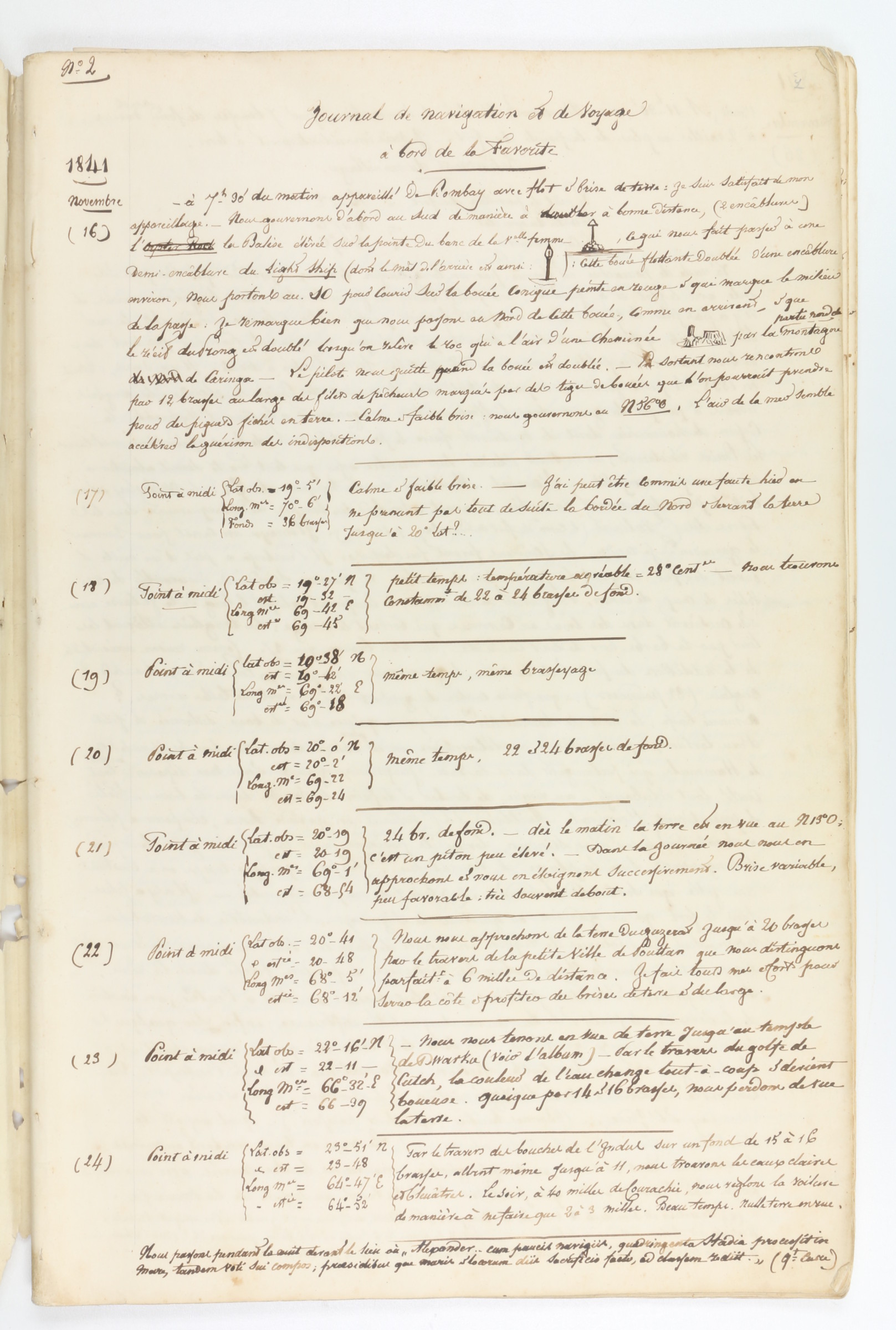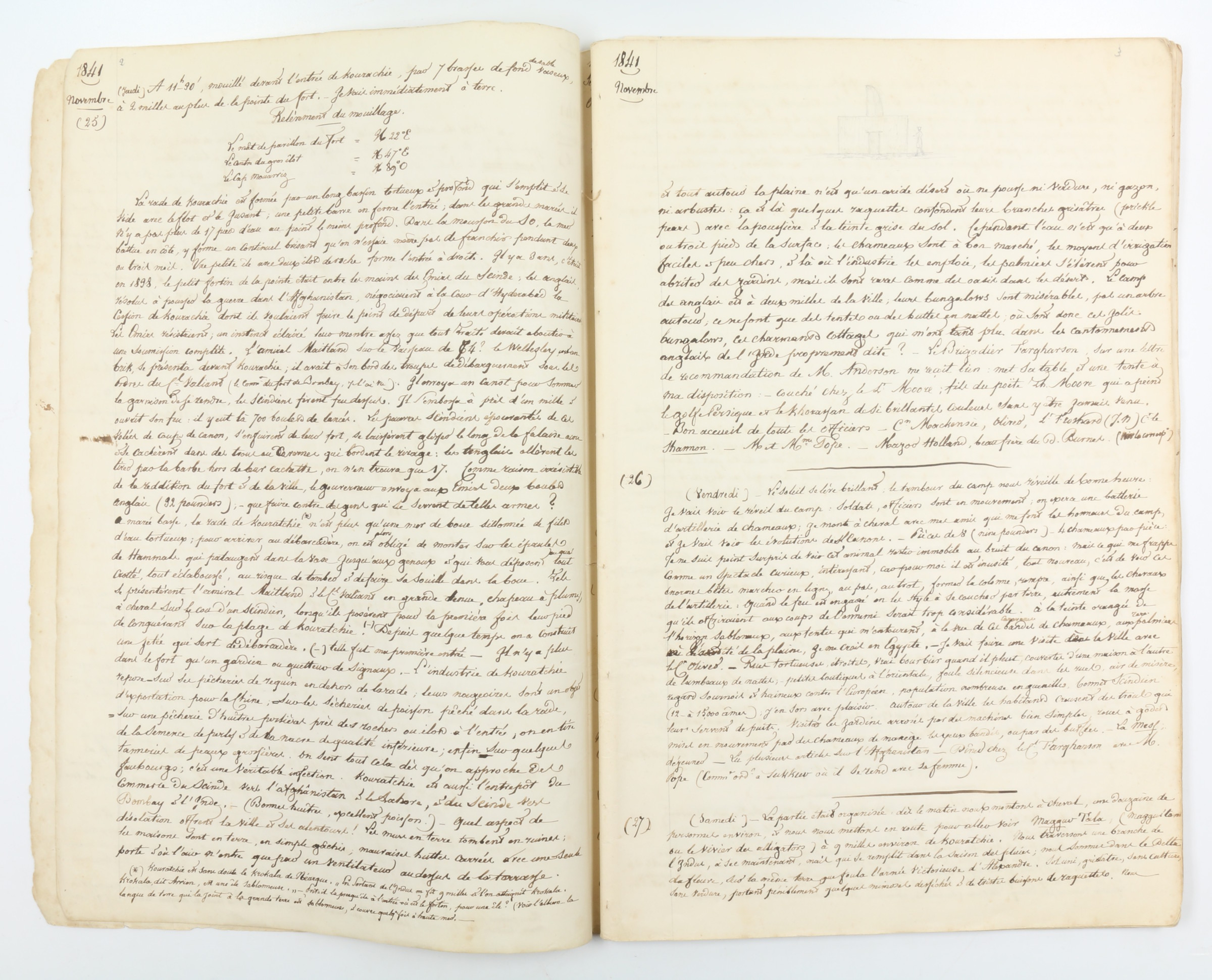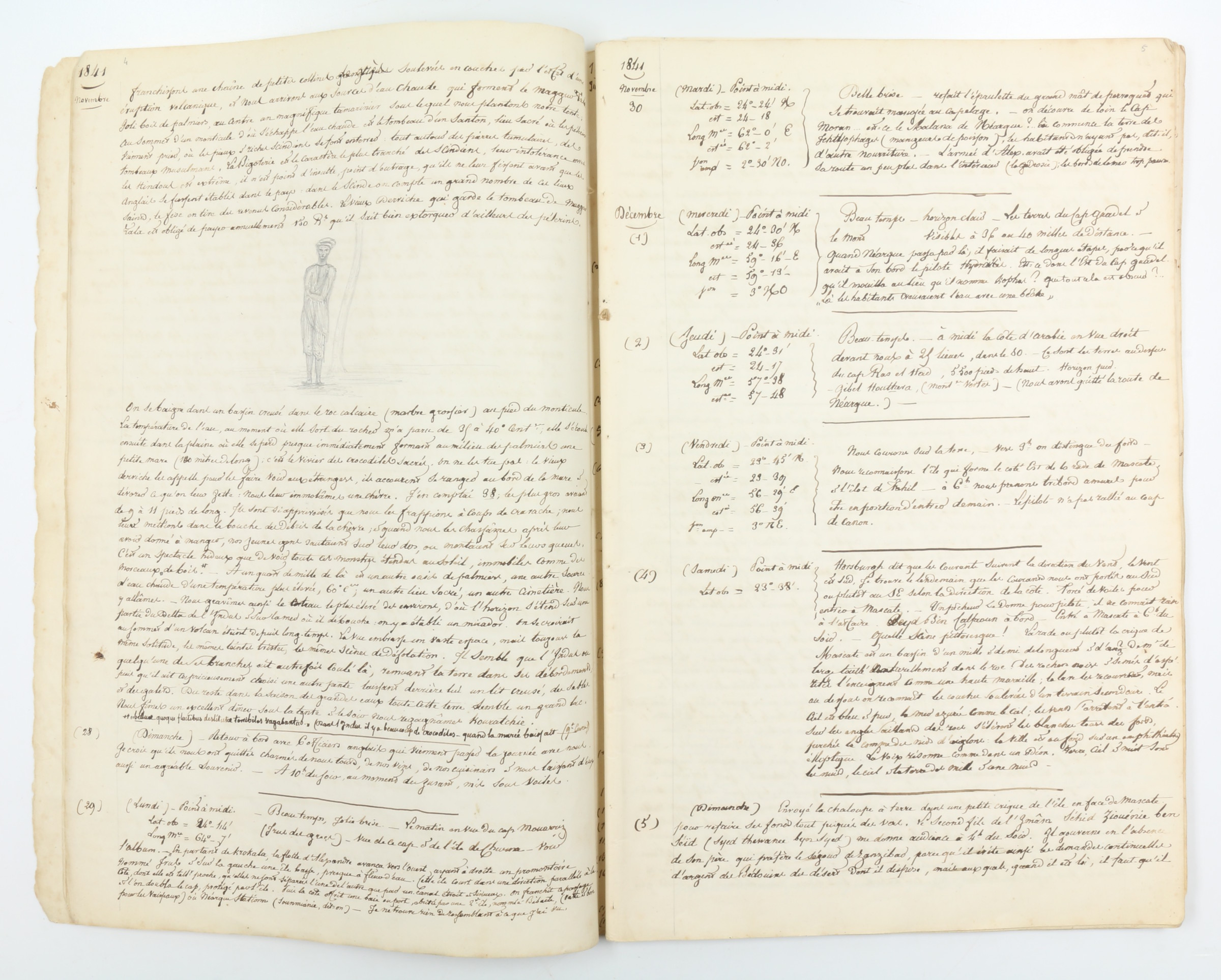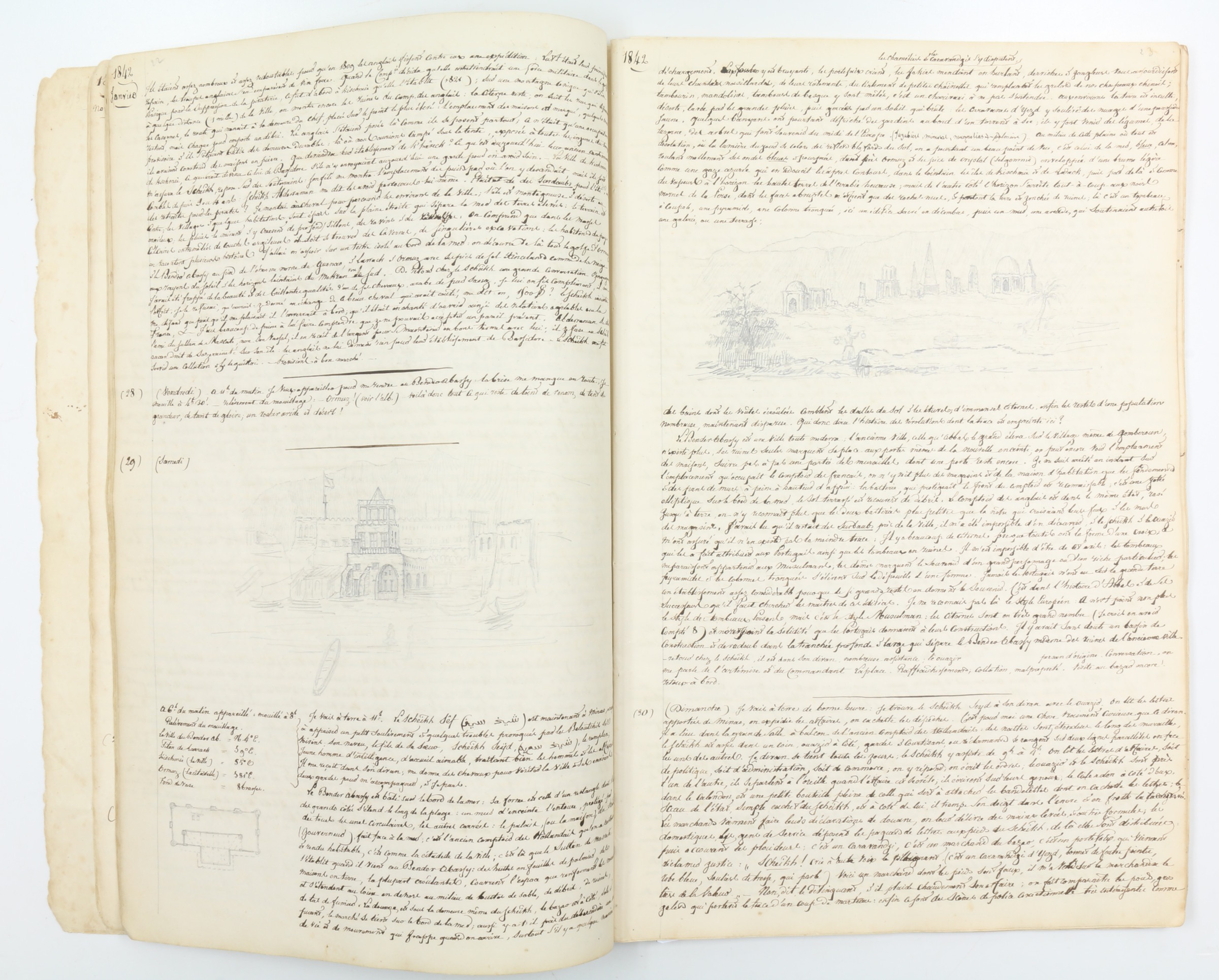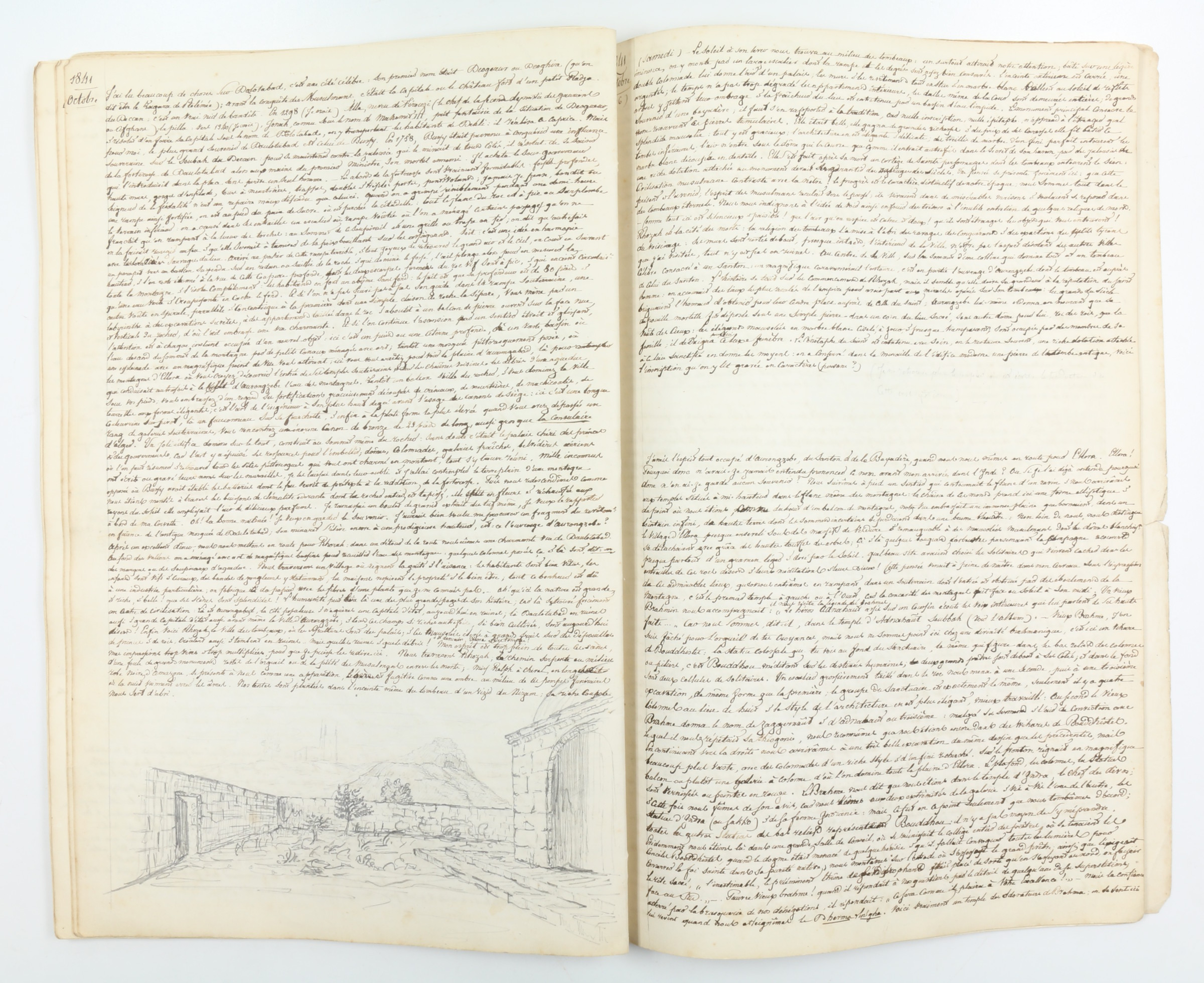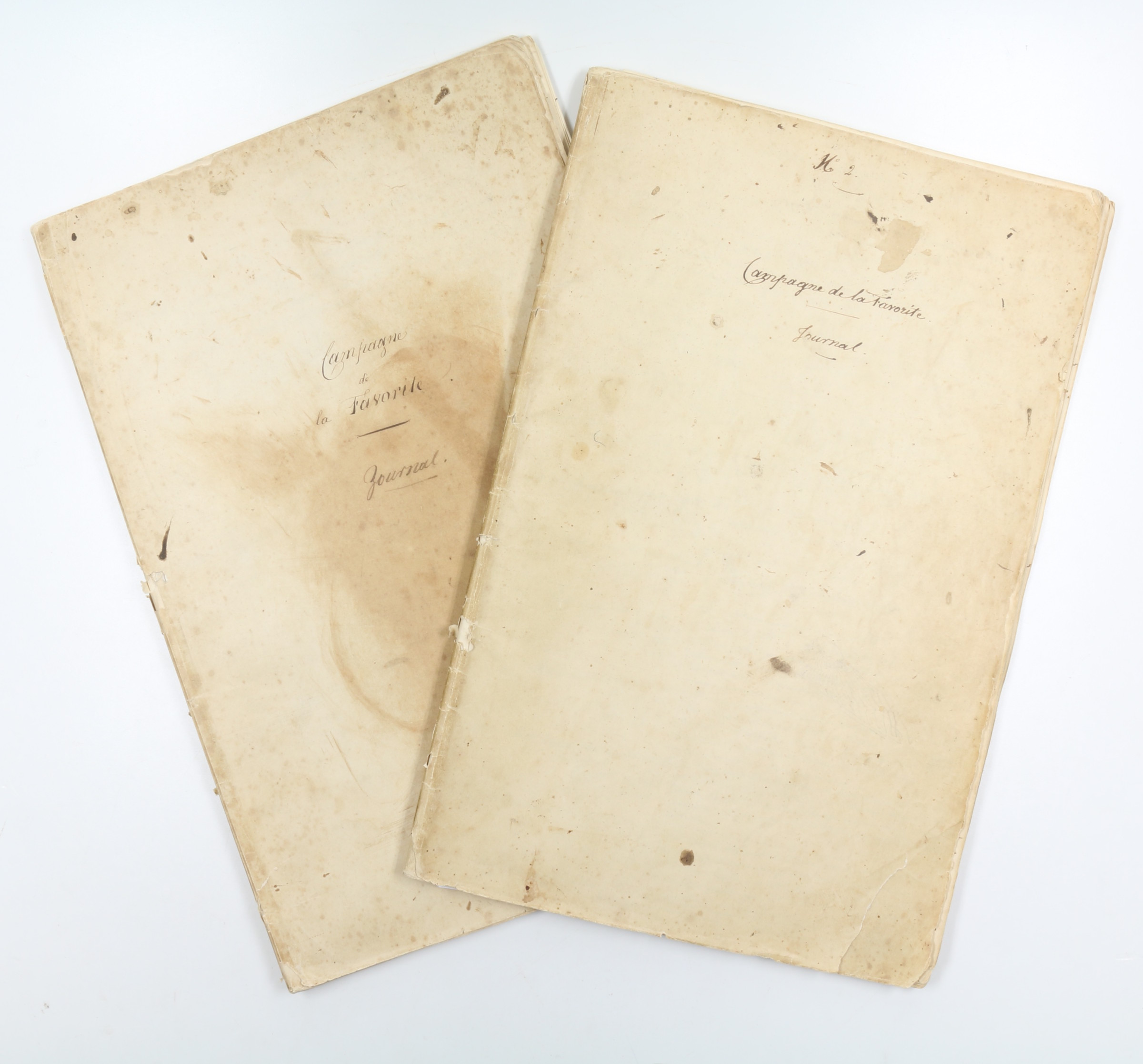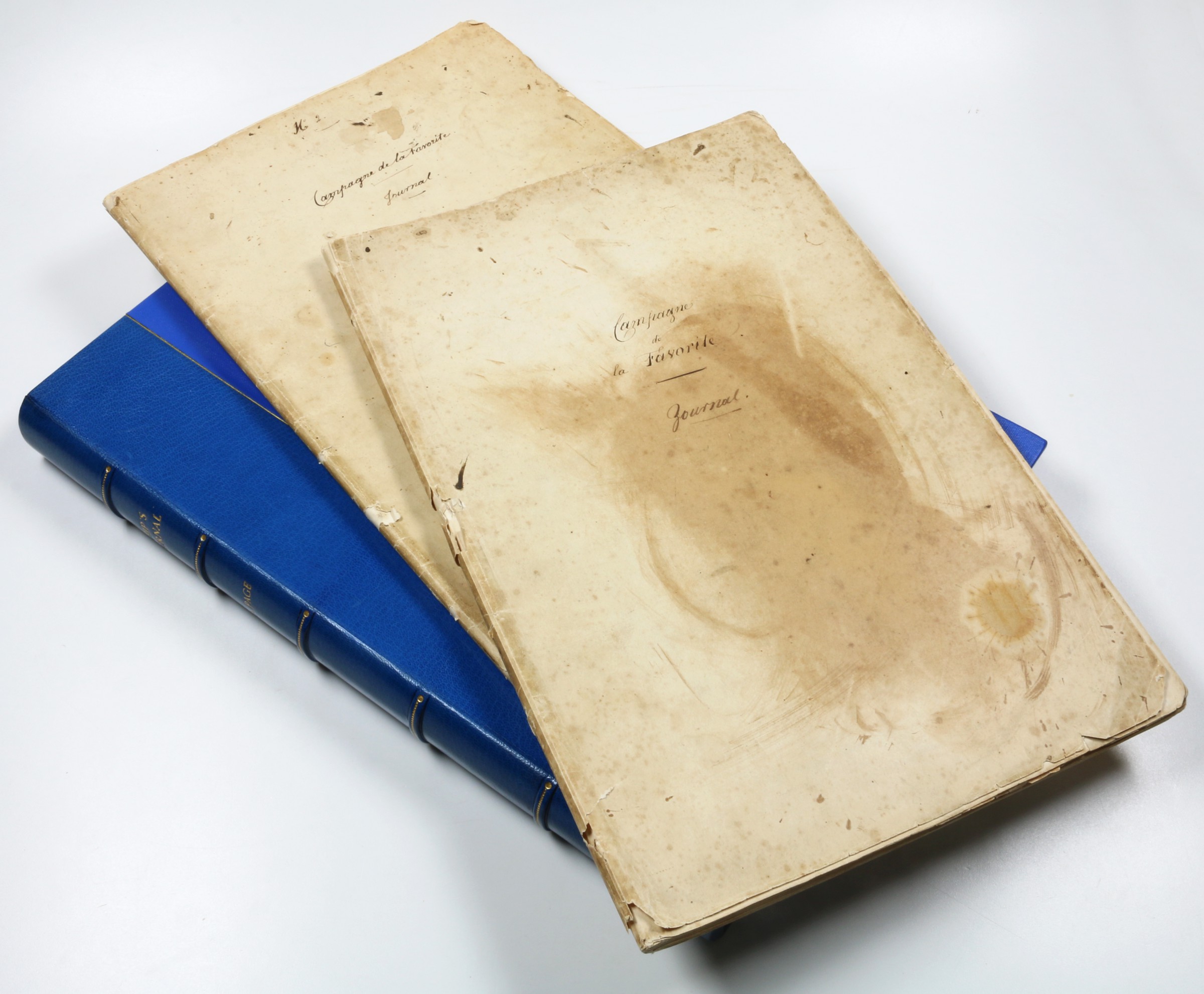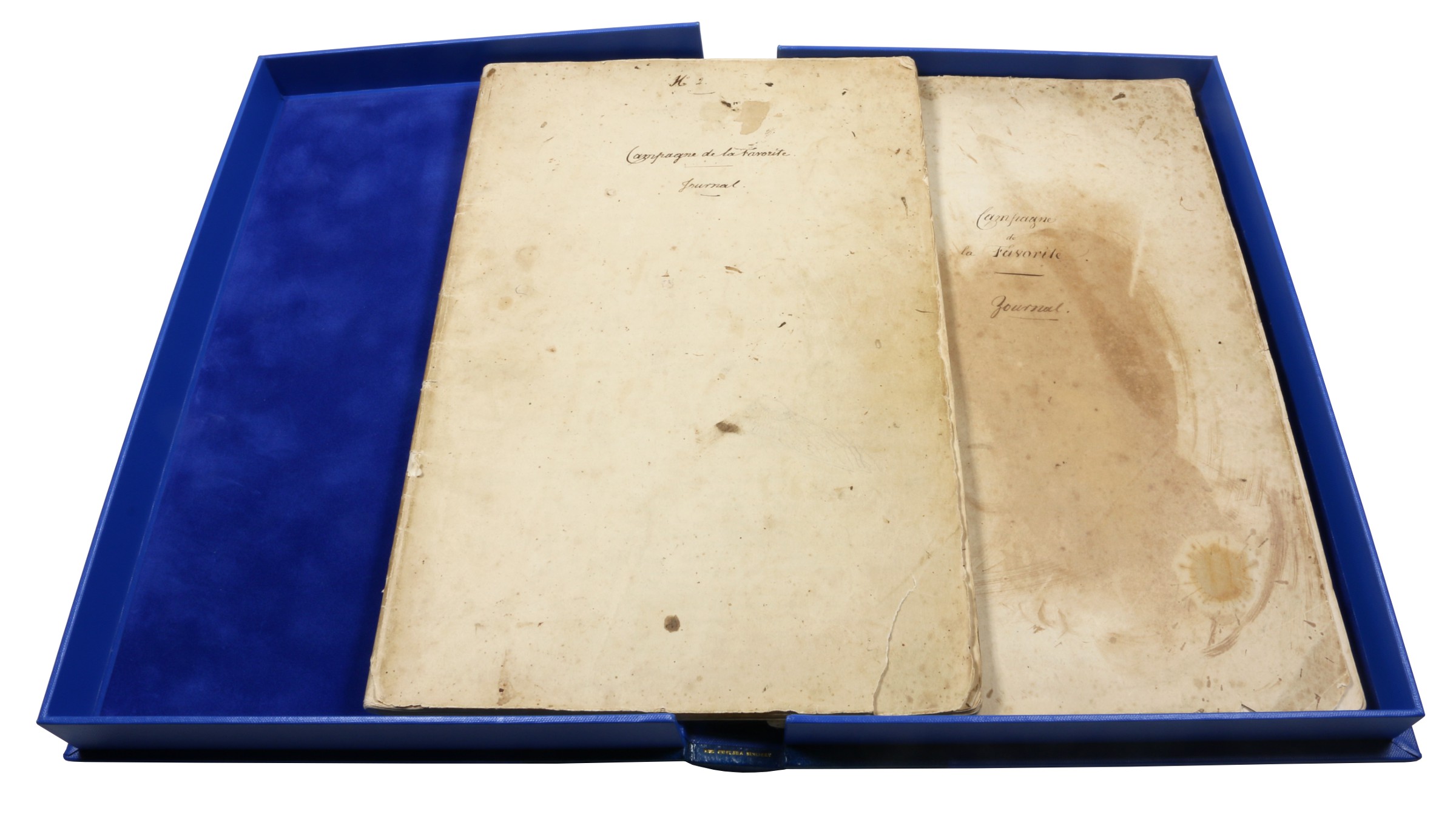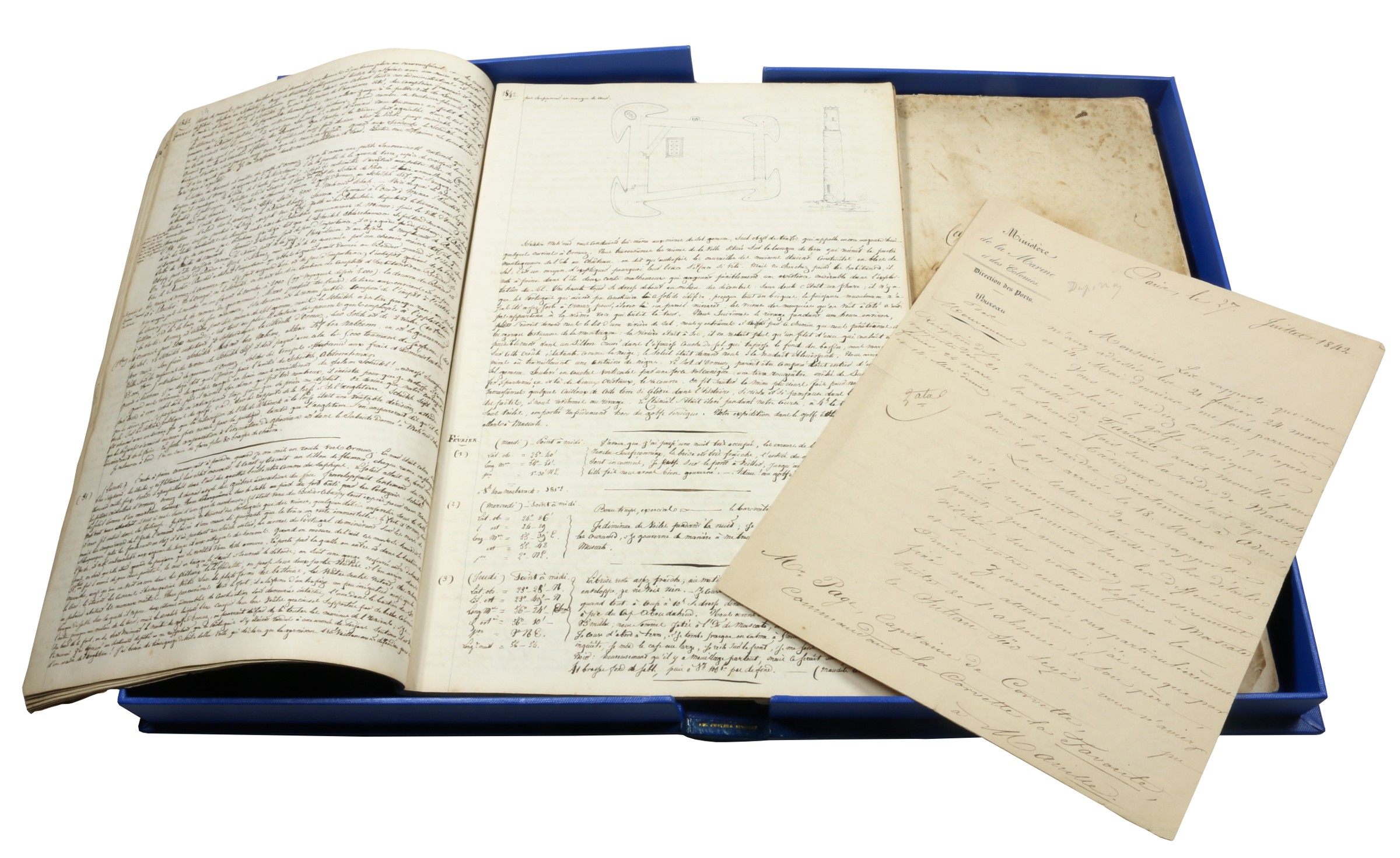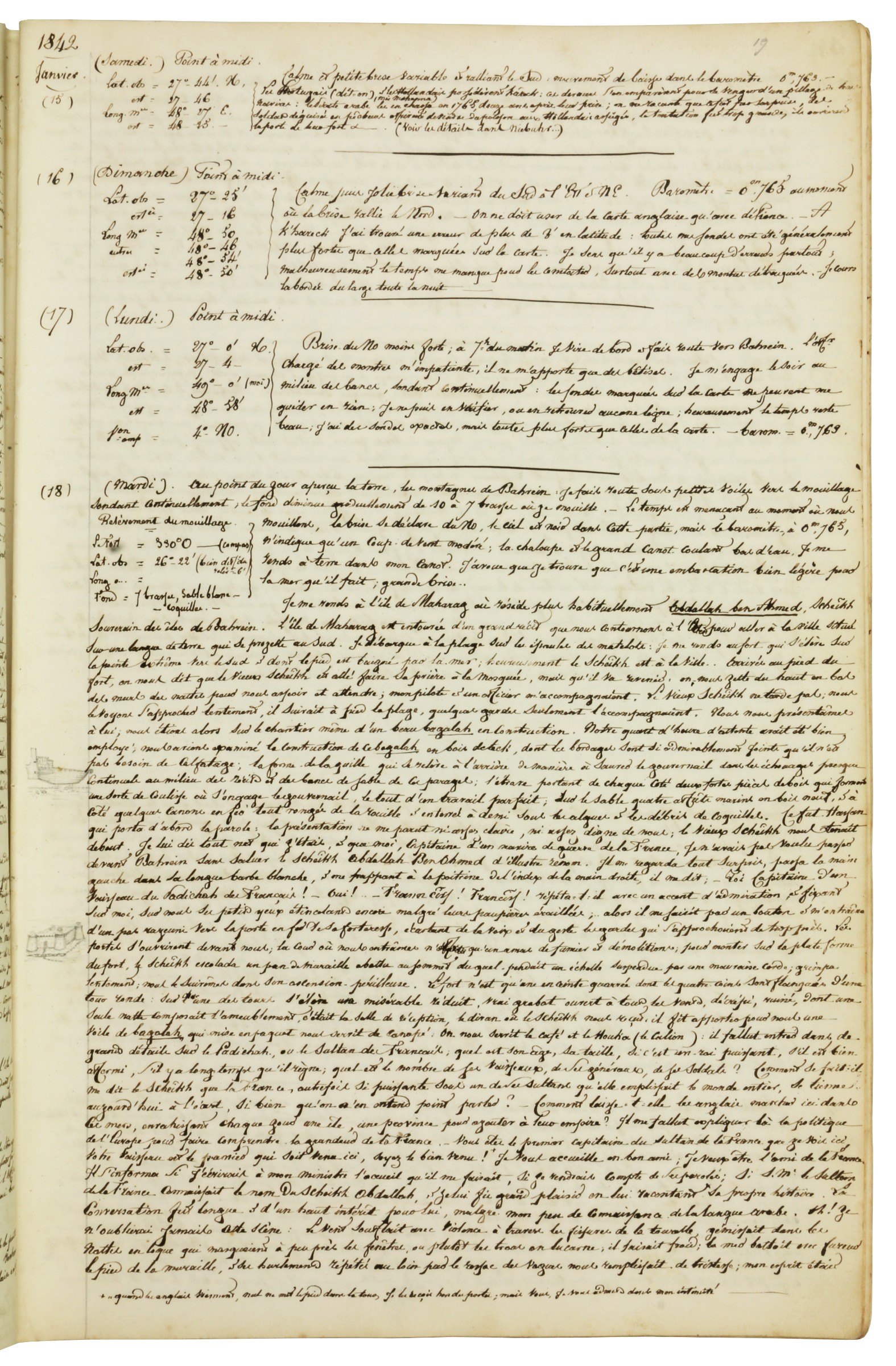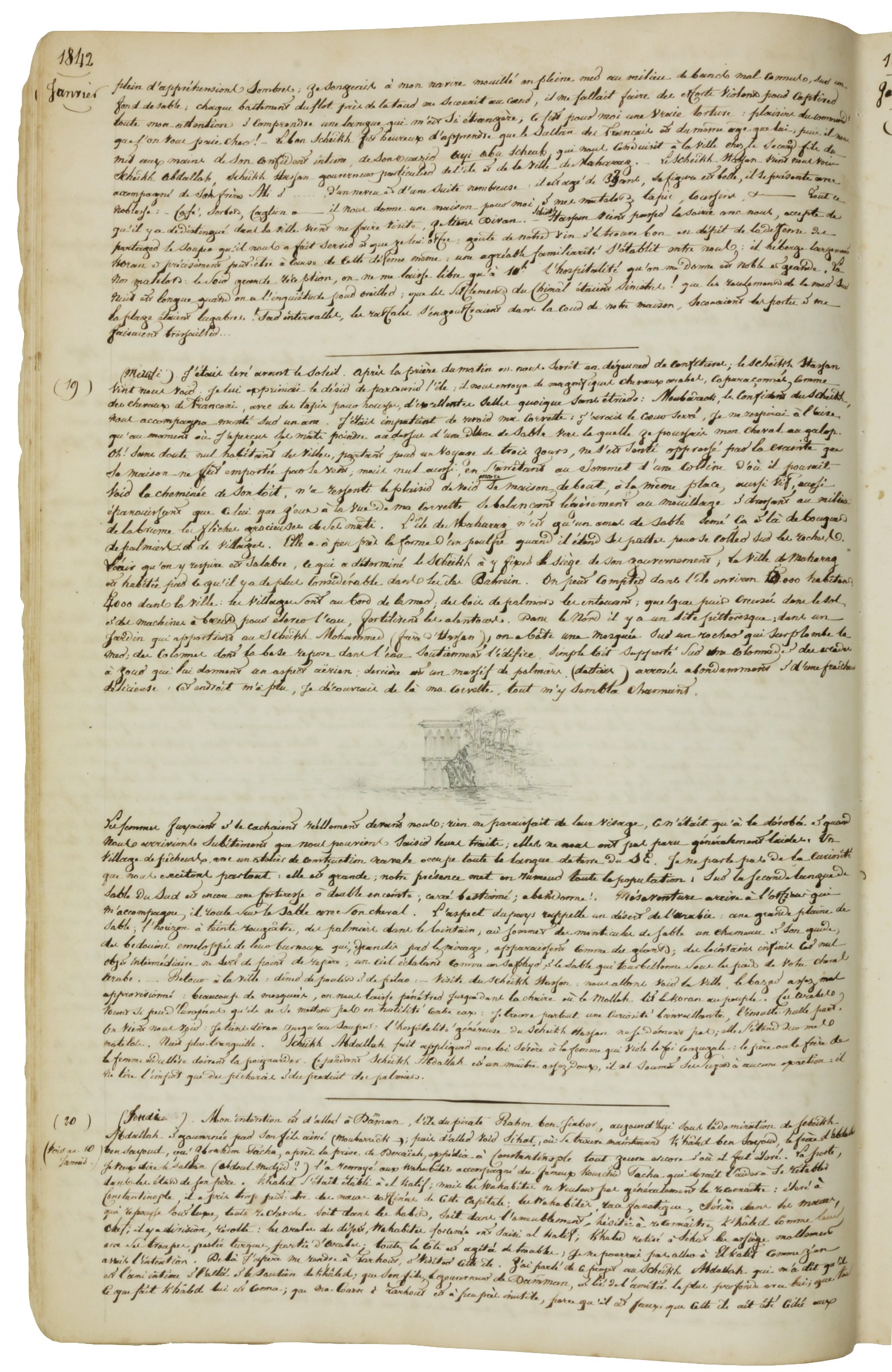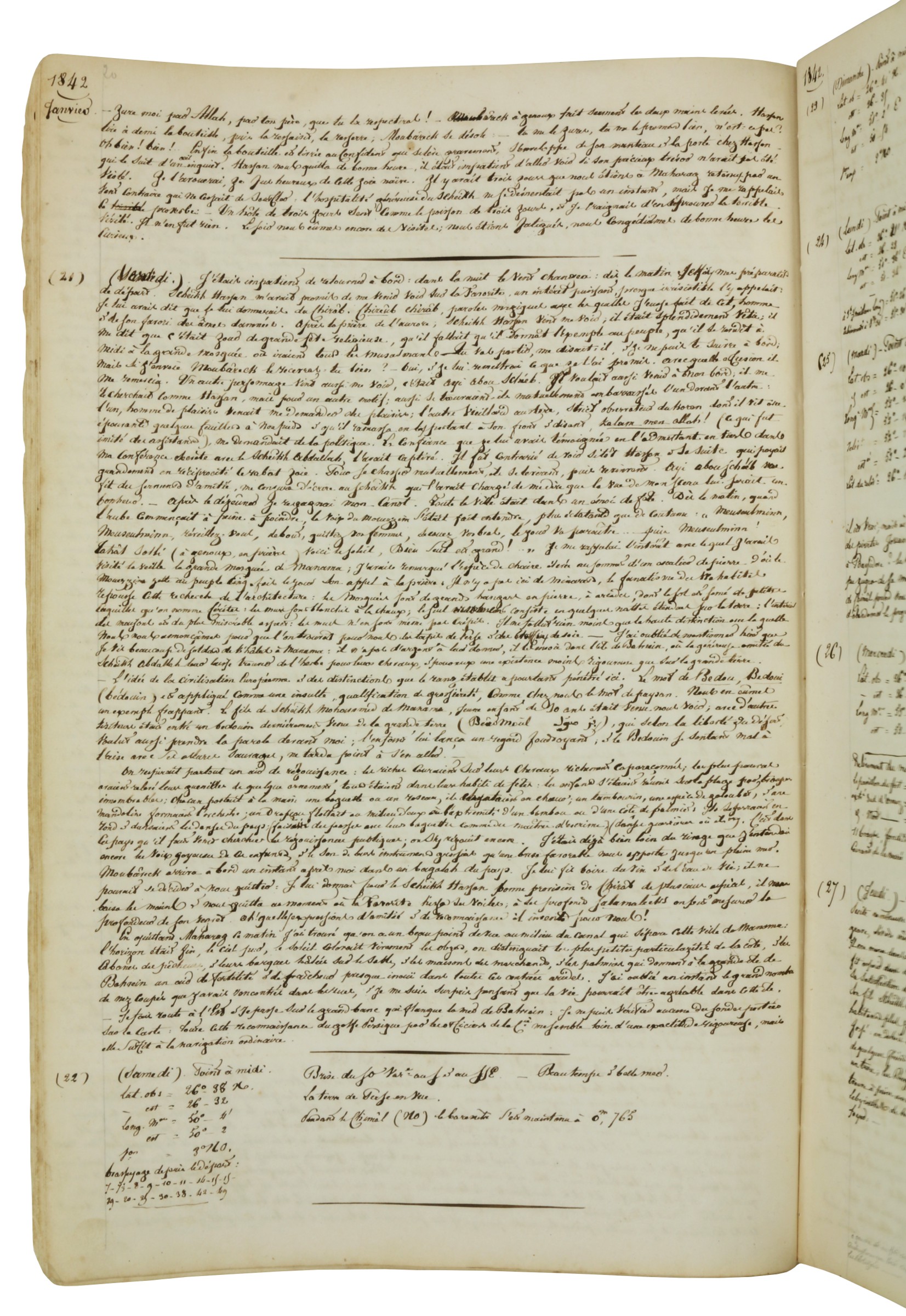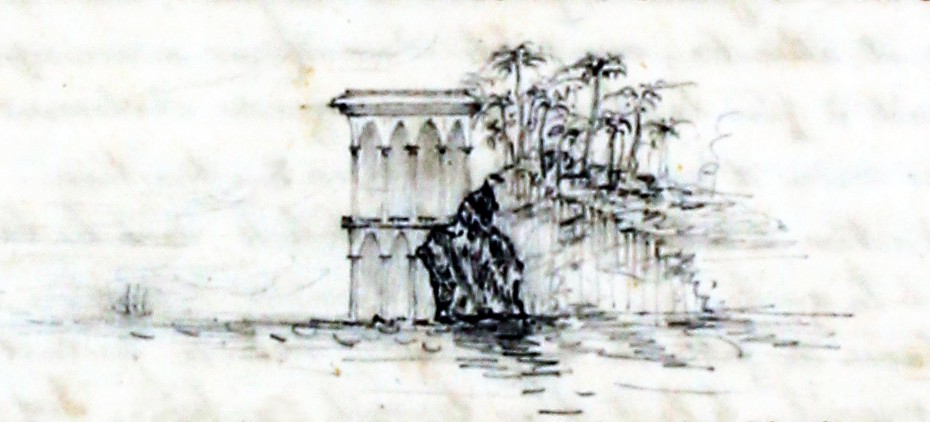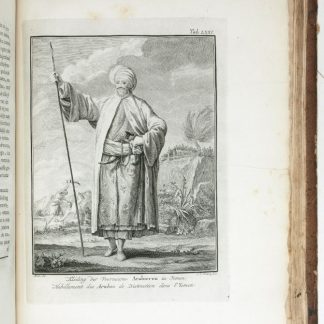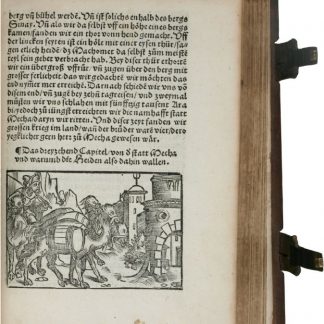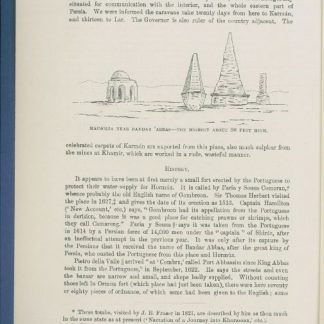[SOLD]
This item has sold. We are always interested in acquiring another copy or any item of comparable quality.
A highly important illustrated account of a visit to Muscat and the Sultan of Oman, hitherto unpublished
Campagne de la Favorite - Journal.
Autograph ship's journal in French. Folio (335 x 220 mm). 2 vols. with a total of 192 unnumbered pages (of which 30 are blank). In black ink, with more than 40 small pen or pencil drawings in the text, ranging from simple coastal profiles to detailed and skilfully executed views of cities and fortifications. With 11 inserted items, including a 27 July 1842 letter from Admiral Guy-Victor Duperré (Ministère de la Marine et des Colonies) to Captain Page, and a slip with neatly drawn Chinese characters. Contemporary plain-paper wrappers, with manuscript title on both front wrappers. Stored in custom-made half morocco case with gilt title to spine.
Primary source for the very first French diplomatic mission to the Arabian Gulf, the trucial Sheikhdoms, Oman and Bahrein, which was published only in extracts (Billecoq 2001, cf. below) and of which to this day no critical edition exists. The Captain's meticulous, illustrated account of the voyage of the French corvette La Favorite, departing under his command from Brest on 3 June 1841, sailing around Africa and along Madagascar to India and the Gulf (extensively exploring both the Arabian and the Persian coasts as far as present-day Kuwait), around the Arabian Peninsula into the Red Sea, then around the southern tip of India to the East Indies, the South China Sea and up the Chinese coast as far as Zhejiang province. "Its journey across the eastern seas, especially to the Gulf, was a landmark event. For the first time, a French government was dispatching a ship on a mission to the Gulf, specifically to the Sovereign of the States of the Bahrain Islands" (Billecocq).
While Page often records brief pieces of information about the weather and coordinates, he includes much more descriptive text than most ships' journals, and often illustrates the account with drawings of fortifications (often quite detailed), natural landmarks, tornados and locals, as well as clothes, utensils and other objects. The journal also gives much detail of the return voyage through the seas around the East Indies, but only brief reports for the further voyage home, ending on 5 January 1844.
The first volume closes on 17 October 1841, when Page visited the Kailasanatha temple (Ellora, India). The next volume starts nearly a month later, on 16 November, when the ship was near Bombay. They sailed, via Karachi (Pakistan), to Muscat, where they arrived on 4 December. There Page was received by the "second son" of Said bin Sultan al Said (1791-1856), the Sultan of Muscat and Oman, who himself was staying at Zanzibar. Sayyid Thuwaini bin Said al-Said (1821-71), actually the Sultan's third son, would succeed his father in 1856. Page describes Thuwaini and his residence, and on the following days describes the city's harbour and fortifications, the market (where one could buy pearls, rhinoceros skin and coconut oil from Africa, Indian ghee and much more) and some surrounding villages. He also includes a small drawing of a veiled woman. The ship left the city on 9 December, sailing north through the strait of Hormuz (16 December) and continuing along the Persian coast. On 25 December it reached "Cangoun" (Bandar-e Kangan, Persia), where Page visited Sheikh Diégara (or Diegarah) at his house near the sea for two days. He gives a description of the Sheikh's house and its surroundings, again including a drawing of a veiled woman and a small drawing of a "machine singalière" that watered the gardens (a well with a pump?). On 31 December, back at sea again, Page had a conversation with his Arabic guide about Abdullah bin Saud, who ruled the first Saudi State from 1814 to 1818, and his imprisonment by Ibrahim Pasha of Egypt (1789-1848). They also discussed the infamous pirate "Rah'm Ben Jaber": Rahmah ibn Jabir Al Jalhami (ca. 1760-1826), his father Jabir bin Adhbi and their relation to Sheikh Abdullah bin Ahmad Al Kalifa, the ruling family of Bahrain. On 2 January 1842 La Favorite anchored at Bushehr, where Page met a certain "Monsieur Malcolm" who invited him to visit Sheikh Nasr (Nasser) in the house that was built by Nasr's father, Sheikh Abdur Rassoul. Page stayed there for several days, going horse-back riding with the Sheikh, describing the region and provisioning his ship before leaving on 7 January. The following day Page visited a fortress, shown in some small drawings in the present journal. On 14 January La Favorite sailed for Bahrein, arriving on the 18th. "This was a truly singular historic event, being the first time that diplomatic relations were established between France and the renowned Gulf islands, so influential in the history of the Middle East and of world civilizations" (Billecocq). He went ashore at Muharraq, where he was welcomed by the ruler, Sheikh Abdullah bin Ahmad al Khalifa. It has recently been suggested that Abdullah was a much greater and more important figure in Bahrain's history than has been previously recognised (cf. Abdulaziz Mohamed Hasan Ali al Khalifa, Relentless warrior and shrewd tactician: Shaikh Abdullah bin Ahmad of Bahrain 1795-1849, PhD thesis, University of Exeter, 2013). According to Page, the Sheikh was very interested in France and its "sultan", asking many questions and saying: "You are the first of the French sultan's captains I have seen here. Your ship is the first to come here, welcome!" (vol. 2, p. 19). Later that day Page visited the Sheikh's son Hassan and Ali, where he dined. The next day Page was given some "splendid" Arab horses to explore the island with. He gives a description of Muharraq, the mosques, the bazaar, and some surroundings. On 20 January Page writes he wants to visit the "île du pirate Rah'm ben Jimber" (island of the pirate Rahm bin Jabir), but was unable to do so and visited Manama instead. He gives a vivid picture of the bazaar, mentioning dates from the south, woolen cloth from Lassa, fabric from Bombay, pearls, etc. He also briefly touches on the Portuguese influence in the region. On 21 January Sheikh Hassan came aboard La Favorite, and Page enjoyed the festivities in the city. The ship left Bahrein on 22 January and arrived at the isle of "Kichmie" (probably Qishm, Iran, since Page mentioned he could see Ormuz) on 27 January, where he met Sheikh Abderaman. Included here are some relatively large architectural drawings of the Sheikh's house, the harbour, a view with some ruins and a ground plan of a fortress. Page gives lengthy description of each day up to the first of February, when the ship left for Muscat. La Favorite anchored at Muscat from 6 to 21 February to reprovision for the long journey to the East Indies. "While waiting for the ship to be prepared for the journey, Page left to explore the area around the Omani capital and discovered the charming valley of Al-Bustan" (Billecocq).
Page's decision to keep within this journal the letter by Admiral Duperre, Ministère de la Marine et des Colonies, adressed to him from Paris, 27 July 1842, makes perfect sense, as the Admiral congratulates Page extensively on his very interesting report on the Gulf: "Vous me rendiez compte, qu’après avoir exploré le golfe Persique, la corvette la Favorite avait mouillé pour la seconde fois sur la rade de Mascate [...] La lecture de ces rapports m’a vivement intéressé et les détails qu’ils renferment sur les différents points que vous avez successivement visités [...] ont particulierèment fixé mon attention". Obviously Page was well aware of the importance and unique value of his observations made during a journey still characterized in the 21st century as a "landmark event" (Billecoq), all of which finally comes to light through the present journal.
Provenance: Chateau de Vincennes, Paris, deaccessioned and sold to the Swedish Bookseller and collector Björn Löwendahl, bought from his heirs.
Xavier Beguin Billecocq, Un vasseau français à Bahreïn, 1842: une première diplomatique / A French ship's journey to Bahrain, 1842: a diplomatic first (Paris 2001). Bequin Billecocq, Oman, pp. 190f. J. Peterson, Historical Muscat, p. 129 ("unpublished manuscript, cited in Billecocq").


